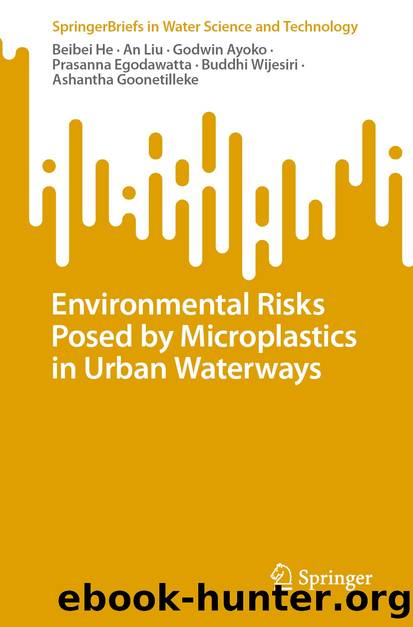Environmental Risks Posed by Microplastics in Urban Waterways by Beibei He & An Liu & Godwin Ayoko & Prasanna Egodawatta & Buddhi Wijesiri & Ashantha Goonetilleke

Author:Beibei He & An Liu & Godwin Ayoko & Prasanna Egodawatta & Buddhi Wijesiri & Ashantha Goonetilleke
Language: eng
Format: epub
ISBN: 9789819906284
Publisher: Springer Nature Singapore
3.3.2 Microorganisms
The MPs outer surface can act as a hard-substrate providing a stable environment for the growth of bacteria, viruses, and other microorganisms. Compared to most natural substrates, MPs provide more opportunities for microbial community colonisation and biofilm formation due to their longer life and hydrophobic surface, and therefore, act as vectors for pathogens and exotic species. According to research undertaken by Eckert et al. (2018), a significant relationship exists between the increase in MP abundance and the relative survival rate and richness of the microbial community in both, wastewater and natural freshwater. Additionally, a diverse microbial community of heterotrophs and autotrophs have been found to colonise MPs debris (Zettler et al. 2013). A study of the North Pacific Subtropical Gyre found that increased MPs pollution has resulted in an overall increase in water strider (Halobates serious) egg densities (Goldstein et al. 2012).
The physicochemical property of MPs is regarded as the vital factor in microbial-MPs interaction. Past studies have attributed different characteristics of microorganisms accumulated on MPs to different composition and structural properties of each polymer type. MPs with low hazardous additives such as PE and PP provide more favourable conditions for microorganism growth. Furthermore, MP particles with rough surfaces would have high susceptibility to biofilm biomass accumulation than those with smoother surfaces. After being discharged to the environment and exposed to ultraviolet radiation, MPs surface structure such as roughness and porosity will be modified by weathering, resulting in greater biofilm accumulation. This is because the degraded MPs with higher surface area to volume ratio would provide more favourable conditions for microorganism colonisation, especially for those degraded MPs which contain relatively less hazardous chemical compounds (He et al. 2020). Further, environmental parameters such as salinity, pH, dissolved oxygen and temperature will influence the process of plastic-associated biofilm formation. This is because the ambient conditions would change microorganism activities such as reproduction and biotransformation.
According to He et al. (2020), nutrients, namely, TC, TN and TP have been identified to be positively correlated to MPs abundance due to microorganism establishment on the particle surface. Additionally, the colonised microorganisms on the surface would also facilitate the degradation of MP particles resulting in more hazardous leachate (He et al. 2022). Further, such degraded MPs due to the interaction with microorganism would in turn enhance the adsorption capacity for contaminants present in the surrounding environment on their surfaces. Consequently, this would result in water and sediment quality deterioration. Moreover, due to dispersal and transport processes, such microorganism bonded MPs would serve as a vector for alien organisms to be transported, leading to exotic species invasion and changes to fauna community structure. This in turn, would pose population level threats to aquatic habitat, leading to community-wide or ecosystem-wide adverse consequences.
Download
This site does not store any files on its server. We only index and link to content provided by other sites. Please contact the content providers to delete copyright contents if any and email us, we'll remove relevant links or contents immediately.
Whiskies Galore by Ian Buxton(41530)
Introduction to Aircraft Design (Cambridge Aerospace Series) by John P. Fielding(32888)
Small Unmanned Fixed-wing Aircraft Design by Andrew J. Keane Andras Sobester James P. Scanlan & András Sóbester & James P. Scanlan(32573)
Aircraft Design of WWII: A Sketchbook by Lockheed Aircraft Corporation(32134)
Craft Beer for the Homebrewer by Michael Agnew(17933)
Turbulence by E. J. Noyes(7700)
The Complete Stick Figure Physics Tutorials by Allen Sarah(7141)
The Institute by Stephen King(6802)
Kaplan MCAT General Chemistry Review by Kaplan(6595)
The Thirst by Nesbo Jo(6437)
Bad Blood by John Carreyrou(6275)
Modelling of Convective Heat and Mass Transfer in Rotating Flows by Igor V. Shevchuk(6223)
Learning SQL by Alan Beaulieu(6035)
Weapons of Math Destruction by Cathy O'Neil(5829)
Man-made Catastrophes and Risk Information Concealment by Dmitry Chernov & Didier Sornette(5647)
Permanent Record by Edward Snowden(5537)
Digital Minimalism by Cal Newport;(5389)
Life 3.0: Being Human in the Age of Artificial Intelligence by Tegmark Max(5184)
iGen by Jean M. Twenge(5161)
